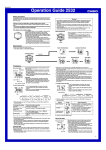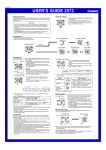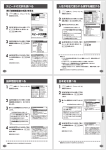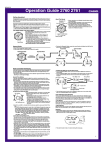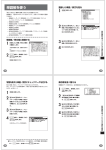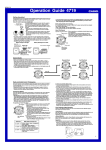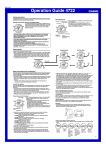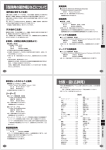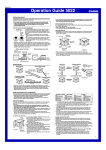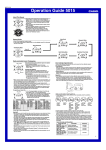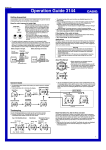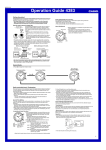Download Casio casio 2762 User's Manual
Transcript
MO0404-EA Operation Guide 2762 Getting Acquainted Congratulations upon your selection of this CASIO watch. To get the most out of your purchase, be sure to read this manual carefully and keep it on hand for later reference when necessary. • This watch does not have a time zone that corresponds to the Greenwich Mean Time differential of –3.5 hours. Because of this, the radio-controlled timekeeping and Dual Time functions will not display the correct time for Newfoundland, Canada. About This Manual • Button operations are indicated using the letters shown Stopwatch 1/20 in the illustration. second dial • Most of the display examples in this manual show only Hour hand Minute hand the digital display, without the analog hands. • Each section of this manual provides you with the information you need to perform operations in each mode. Further details and technical information can be found in the “Reference” section. Expose the watch to bright light to charge its battery before using it. You can use this watch even as its battery is being charged by exposure to bright light. • Be sure to read “Power Supply” of this manual for important information you need to know when exposing the watch to bright light. Second If the digital display of the watch is blank... Digital display If the digital display of the watch is blank, it means that the watch’s Power Saving function has turned it off to conserve power. Power Saving automatically turns off the display and enters a sleep state whenever the watch is left for a certain period where it is dark. • The initial factory default setting is Power Saving on. • The watch will recover from the sleep state if you move it to a well-lit area,* if you press any button, or if you angle the watch towards your face for reading. * It can take up to two seconds for the display to turn on. • See “Power Saving” for more information. General Guide • Press C to change from mode to mode. • In any mode, press D to illuminate the face of the watch. Timekeeping Mode Digital display hand 24-hour dial Battery level dial • Entering the Stopwatch Mode causes the second hand and battery level dial hand to move to the 12 o’clock position. Recall Mode Dual Time Mode Stopwatch Mode ▲ ▲ ▲ Press C. ▲ Alarm Mode Hand Setting Mode ▲ ▲ Radio-controlled Atomic Timekeeping Current Time Setting This watch automatically adjusts its digital time setting in accordance with a time calibration signal. You can also perform a manual procedure to set the time and date, when necessary. • The first thing you should do after purchasing this watch is to specify your Home Time Zone, which is the time zone where you will normally use the watch. For more information, see “To specify your Home Time Zone” below. • When using the watch outside the range of the U.S. and Japanese time signal transmitters, you have to adjust the current time setting manually as required. See “Timekeeping” for more information about manual time settings. • The analog time of this watch is synchronized with the digital time. Because of this, the analog time setting is adjusted automatically whenever you change the digital setting. See “Analog Timekeeping” for more information. Month – Day Year Month – Day Press A. Hour : Minutes ▲ ll Day of week PM indicator Seconds ▲ Receive time ▲ ll l l l lll 2. Use D (+) and B (–) to select the time zone you want to use as your Home Time Zone. • The following are the GMT differential values for major cities in North America and for Japan. Note that if the time zone you selected is in Daylight Saving Time and the signal receiving indicator ( ) is on the display (indicating that the watch has received a signal and has adjusted its GMT differentials for Daylight Saving Time), you must select the GMT differential values shown in the parentheses. – 8.0 (DST – 7.0): Los Angeles, San Francisco, Las Vegas, Seattle/Tacoma, Vancouver, Tijuana – 7.0 (DST – 6.0): Denver, El Paso, Edmonton, Culiacan – 6.0 (DST – 5.0): Chicago, Houston, Dallas/Fort Worth, New Orleans, Winnipeg, Mexico City – 5.0 (DST – 4.0): New York, Detroit, Miami, Boston, Montreal + 9.0: All cities in Japan • Note that this watch does not have a time zone that corresponds to Newfoundland. 3. Press A to exit the setting screen. • The second hand will advance at high speed to the correct position in accordance with the seconds count of the digital time, and resume normal movement from there. To display the digital time and last signal screen • In the Timekeeping Mode, press A to cycle through the digital time screens as shown below. • In the Timekeeping Mode, press B to display the last signal screen. The last signal screen shows the date and time of the last successful time calibration signal reception. ▲ lll To specify your Home Time Zone 1. In the Timekeeping Mode, hold down A until the GMT DST indicator differential value starts to flash, which indicates the setting screen. • The second hand will move at high speed to the 12 lllll o’clock position, where it will stop. l • The GMT differential value indicates the time difference in hours between Greenwich Mean Time and the currently selected time zone. • The DST indicator indicates that Daylight Saving Time GMT differential value (summer time) is turned on for the currently selected time zone. • Normally, your watch should show the correct time as soon as you specify your Home Time Zone. If it does not, it should adjust automatically after the next auto receive operation (in the middle of the night). You can also perform manual receive or you can set the time manually. • Selecting –5.0, –6.0, –7.0, –8.0, or +9.0 as your Home Time Zone automatically turns on auto receive. When auto receive is turned on and you are within the reception range, the watch will automatically receive the time calibration signal from the applicable transmitter (in the middle of the night) and update its settings accordingly. For information about the relationship between time zones (GMT differential values) and transmitters, see “Transmitters”. • See the maps under “Reception Ranges” for information about the reception ranges of the watch. • If you are in an area that does not use Daylight Saving Time (summer time), turn off the DST setting. • If W60, A, J40, J60, or OFF starts to flash in place of the GMT differential value when you hold down A in step 1 of the above procedure, press A again to exit the setting screen. After that, press B and then perform step 1 again. ▲ This watch receives a time calibration signal and updates its time setting accordingly. The time calibration signal includes both Standard Time and Daylight Saving Time (summer time) data. • This watch is designed to pick up the time calibration signal transmitted in the United States (Fort Collins, Colorado) and the time calibration signals transmitted in Japan. • The U.S. time calibration signal can be picked up by the watch while in North America.* term “North America” in this manual refers to the area that consists of * The Canada, the continental United States, and Mexico. Receive date Press B. Last Signal Screen • The last signal screen remains on the display for about one or two minutes. After that, the Timekeeping Mode screen reappears. Time Calibration Signal Reception There are two different methods you can use to receive the time calibration signal: auto receive and manual receive. The second hand stops at the 12 o’clock position while time calibration signal reception is in progress. After reception is complete, the second hand moves automatically until it matches the digital time. • Auto Receive With auto receive, the watch automatically picks up the time calibration signal five times a day at 0:00 a.m., 1:00 a.m., 2:00 a.m., 3:00 a.m., and 4:00 a.m. For more information, see “About Auto Receive”. • Manual Receive Manual receive lets you start a time calibration receive operation with the press of a button. For more information, see “To perform manual receive”. 1 Operation Guide 2762 Metal Band l l l l lll • The watch should not be on its side or facing the wrong way. • Proper signal reception can be difficult or even impossible under the conditions listed below. lll To perform manual receive 1. Place the watch on a stable surface so its top (12 o’clock side) is facing towards a window. 2. While any screen other than the last signal screen is on l l l l l l l l the display in the Timekeeping Mode, hold down B for about two seconds until the watch beeps. 3. Release B and the current date or time will flash to indicate that signal reception has started. • When a receive operation starts, the second hand will Receiving indicator move at high speed to the 12 o’clock position where it will stop until the receive operation is complete. lll Resin Band • Use the receiving indicator as a guide for checking signal strength and for finding the best location for the watch during signal receive operations. • The Level 4 receiving indicator remains on the display in all modes following reception of the time calibration signal and calibration of the watch’s time setting. The Level 4 receiving indicator is not displayed if signal reception was unsuccessful or after manual adjustment of the current time setting. • The Level 4 receiving indicator indicates that at least one of the calibration signal receive operations was successful. Note, however, that the Level 4 receiving indicator is cleared from the display at 3:00 a.m. each day. lll Important! • When getting ready to receive the time calibration signal, position the watch as shown in the nearby illustration, with its 12 o’clock side facing towards a window. Make sure there are no metal objects nearby. • Time calibration signal reception takes from two to seven minutes. In Japan, however, reception can take up to 14 minutes. Take care that you do not perform any button operations or move the watch during this time. • After signal reception is complete, the watch beeps and the display of the watch changes to the last signal screen. Inside or among buildings Inside a vehicle Near a construction site, airport, or other sources of electrical noise Near household appliances, office equipment, or a mobile phone Near hightension power lines Among or behind mountains • Signal reception is normally better at night than during the day. • Time calibration signal reception takes from two to seven minutes, but in some cases it can take as long as 14 minutes. Take care that you do not perform any button operations or move the watch during this time. • When within range of the applicable transmitter, this watch can receive either the U.S. (Fort Collins, Colorado) or Japanese (Fukushima or Fukuoka/Saga) time calibration signals. See “Transmitters” for more information. Reception Ranges 600 miles 2,000 miles 500 kilometers 500 kilometers Fukuoka/Saga Fukushima 1,000 kilometers Fort Collins 1,000 kilometers • Under good reception conditions, signal reception is possible within a radius of about 2,000 miles (3,000 kilometers) from the Fort Collins transmitter. • At distances further than about 600 miles (1,000 kilometers) from the Fort Collins transmitter, signal reception may not be possible during certain times of year or times of day. Radio interferance may also cause problems with reception. • At distances further than about 500 kilometers from the Fukushima and Fukuoka/ Saga transmitter, signal reception may not be possible during certain times of year or times of day. Radio interferance may also cause problems with reception. • See the information under “Signal Reception Troubleshooting” if you experience problems with time calibration signal reception. About Auto Receive When auto receive is turned on, the watch automatically starts to receive the time calibration signal when the digital time in the Timekeeping Mode reaches 0:00 a.m., 1:00 a.m., 2:00 a.m., 3:00 a.m., and 4:00 a.m. each day (calibration times). The watch will also perform an additional auto receive operation at 5:00 a.m. if none of the regularly scheduled auto receive operations are successful. Note • Auto receive turns on automatically whenever you select –5.0, –6.0, –7.0, –8.0, or +9.0 as your Home Time Zone. For information about turning off auto receive, see “To select the transmitter mode”. • The auto receive operation is performed only if the watch is in the Timekeeping Mode or Dual Time Mode when one of the calibration times is reached. It is not performed if a calibration time is reached while an alarm is sounding, or while you are configuring settings (while settings are flashing on the display). • Auto receipt of the calibration signal is designed to be performed early in the morning, while you sleep (provided that the Timekeeping Mode time is set correctly). Before going to bed for the night, remove the watch from your wrist, and put it in a location where it can easily receive the signal. • When auto receive is turned on, the watch receives the calibration signal for two to seven minutes everyday when the time in the Timekeeping Mode reaches each of the calibration times. Do not perform any button operation within seven minutes before or after any one of the calibration times. Doing so can interfere with correct calibration. • Remember that reception of the calibration signal depends on the current time on the digital display. The receive operation will be performed whenever the display shows any one of the calibration times, regardless of whether or not the displayed time is actually the correct time. • When two, three, four, or five receptions are successful, the watch uses the data of the last reception for calibration. When only one reception is successful, the watch uses the data of the successful reception. About the Receiving Indicator The receiving indicator shows the strength of the calibration signal being received. For best reception, be sure to keep the watch in a location where signal strength is strongest. Weak (Level 1) Strong (Level 4) Receiving indicator • Even in an area where signal strength is strong, it takes about 10 seconds for signal reception to stabilize enough for the receiving indicator to indicate signal strength. Note • To interrupt a receive operation and return to the Timekeeping Mode, press B. • If the receive operation is unsuccessful, – – – – – – appears on the display for about one or two minutes. After that, the watch returns to the Timekeeping Mode. • You can also change from the last signal or – – – – – – screen to the normal timekeeping screen by pressing B. Signal Reception Troubleshooting Check the following points whenever you experience problems with signal reception. Problem Cannot perform manual receive. Probable Cause • The watch is not in the Timekeeping Mode. • Your current Home Time Zone setting is not one of the following: – 5.0, – 6.0, – 7.0, – 8.0, or + 9.0. Auto receive is • You changed the time setting turned on, but the manually. Level 4 receiving • The watch was not in the indicator does not Timekeeping or Dual Time appear on the Mode, or you performed some display. button operation during the auto receive operation. • Even if receive is successful, the Level 4 receiving indicator disappears every day at 3 a.m. • If the time is one hour off, the Time setting is DST setting may be incorrect. incorrect following • The Home Time Zone setting is signal reception. not correct for the area where you are using the watch. What you should do • Enter the Timekeeping Mode and try again. • Select –5.0, –6.0, –7.0, –8.0, or +9.0 as your Home Time Zone. • Perform manual signal receive or wait until the next auto signal receive operation is performed. • Check to make sure the watch is in a location where it can receive the signal. • Change the DST setting to Auto DST. • Select the correct Home Time Zone. • For further information, see “Important!” under “Time Calibration Signal Reception” and “Radio-controlled Atomic Timekeeping Precautions”. Stopwatch The stopwatch lets you measure elapsed time, lap times, split times, and two finishes. Stopwatch times are also Second hand Battery Stopwatch 1/20 stored in memory. level dial second dial • The display range of the stopwatch is 59 minutes, 59.99 seconds. • All of the operations in this section are performed in the Stopwatch Mode, which you enter by pressing C. • Entering the Stopwatch Mode causes the second hand and battery level dial hand to move to the 12 o’clock position. • In the Stopwatch Mode, the second hand shows the seconds of the elapsed time measurement, the battery level dial shows elapsed minutes, and the stopwatch 1/20 second dial shows elapsed 1/20 second. Minutes 1/100 second Seconds Note • “Lap time” is the time spent to cover a specific segment of a race, such as one lap around a track. “Split time” is the time spent from the beginning of a race up to a certain point. • The stopwatch continues to run, restarting from zero after it reaches its limit, until you stop it. • The stopwatch measurement operation continues even if you exit the Stopwatch Mode. • The hand of the stopwatch 1/20 second dial revolves for the first minute of each elapsed time operation. After that, it stops automatically at the 12 o’clock position. If you exit the Stopwatch Mode while an elapsed time operation is in progress, the 1/20 second hand will revolve for the first minute after you re-enter the Stopwatch Mode. When you stop an elapsed time measurement, the 1/20 second hand will move automatically from the 12 o’clock position to the current 1/20 second count. • For information about how stopwatch times are stored in memory, see “Memory Management”. • You can adjust the positions of the stopwatch 1/20 second dial and battery level dial hands if they do not align exactly with the 12 o’clock position. See “Adjusting Dial Hand Positions” for more information. To measure elapsed time 1. Press B to start the stopwatch. 2. Press B again to stop the stopwatch. • You can resume the measurement operation by pressing B. 3. Press A to clear the stopwatch to all zeros. 2 Operation Guide 2762 To measure lap times 1. When the stopwatch display shows all zeros, press A to display the lap time screen (indicated by LAP). 2. Press B to start a time measurement. 3. Press A to record the time of the first lap. • This freezes the current lap time on the digital display for about five seconds, while measurement of the next lap time continues internally and elapsed time continues to be indicated by the analog hands. • After five seconds, the lap number of the displayed time appears for one second, and then the elapsed time display for the next lap appears. 4. Repeat step 3 to record more lap times. 5. Press B to stop the stopwatch. 6. Press A to clear the stopwatch to all zeros. • Lap numbers are automatically incremented starting from 1 whenever you press A in step 3 of the above procedure. The maximum lap number is 99. Recording a lap after that causes the lap number count to restart from 00. To delete all stopwatch time records In the Recall Mode, hold down A and B for about two seconds. During that time – –:– –. – – will flash on the digital display. Keep A and B depressed until – –:– –. – – stops flashing. • If you release A and B before – –:– –. – – stops flashing, the watch will return to the stopwatch time record screen without deleting time records. • The lap number will show LAP – – after all of the stopwatch time records are deleted. • Note that lap and split times cannot be deleted individually. • Stopwatch time records can be deleted only when the Stopwatch Mode elapsed time display is cleared to all zeros. Dual Time GMT differential value To measure split times 1. When the stopwatch display shows all zeros, press A to display the split time screen (indicated by SPL). 2. Press B to start a time measurement. 3. Press A to record the time of the first split. • This freezes the current split time on the digital display for about five seconds, while measurement of the next split time continues internally and elapsed time continues to be indicated by the analog hands. • After five seconds, the elapsed time display for the next split appears. 4. Repeat step 3 to record more split times. 5. Press B to stop the stopwatch. 6. Press A to clear the stopwatch to all zeros. To time first and second place finishes 1. When the stopwatch display shows all zeros, press A to display the split time screen (indicated by SPL). 2. Press B to start a time measurement. 3. Press A when the first finisher crosses the finish line. • This freezes the time of the first finisher on the digital display for about five seconds. After that, the display returns to elapsed time measurement. 4. Press B when the second finisher crosses the finish line, and display the time. 5. Press A to clear the stopwatch to all zeros. Memory Management Any time you start a new elapsed time measurement (from all zeros) in the Stopwatch Mode, the watch automatically deletes all of the stopwatch time records currently in memory. • The following table shows Stopwatch Mode operations, and how they affect memory storage. To do this: Clear all stopwatch times from memory and start elapsed time measurement Pause an elapsed time measurement without storing data in memory Restart a paused elapsed time measurement without storing data in memory Record a lap or split time in memory during ongoing elapsed time measurement Record the currently paused elapsed, lap, or split time in memory Press this button: B (when all zeroes are displayed) B B A A (clears display to all zeros) Current time in the selected time zone To view the time in another time zone While in the Dual Time Mode, press B to scroll westward through time zones. • When you release B, the displayed GMT differential value is replaced by the current time in that time zone after about one second. • Pressing A causes the applicable GMT differential value of the currently selected time zone to appear on the digital display for about one second. • If the current time shown for a time zone is wrong, check the Timekeeping Mode time setting and your Home Time Zone setting, and make the necessary changes. To toggle a time zone between Standard Time and Daylight Saving Time 1. In the Dual Time Mode, use B to display the time zone DST indicator whose Standard Time/Daylight Saving Time setting you want to change. 2. Hold down A to toggle between Daylight Saving Time (DST indicator displayed) and Standard Time (DST indicator not displayed). • The DST indicator appears on the display whenever you display a time zone for which Daylight Saving Time is turned on. • The DST/Standard Time setting you configure affects only the currently displayed time zone. Other time zones are not affected. • Note that you cannot use the Dual Time Mode to change the DST setting of the Home Time Zone you currently have selected in the Timekeeping Mode. See “To change the Daylight Saving Time (summer time) setting” for information about turning the Home Time Zone DST setting on and off. • The G0.0 (Greenwich Mean Time) time zone cannot be switched between Standard Time and Daylight Saving Time. Alarms The Alarm Mode gives you a choice of four one-time Alarm number alarms and one snooze alarm. One of the one-time • The watch has enough memory to hold up to 50 lap/split time records. Recording a lap or split time while there are already 50 records in memory deletes the oldest record to make room for the new one. • See “Recall Mode” for details on how to recall time records from memory. Recall Mode Lap number The Dual Time Mode lets you view the current time in 29 time zones around the world. • Time zones are indicated on the digital display by their GMT differential values. • For full information on time zones, see the “Time Zone Table”. • The watch will perform a signal receive operation even if it is in the Dual Time Mode when a calibration time is reached. If this happens, the Dual Time Mode time settings will be adjusted in accordance with the current time in the Timekeeping Mode’s Home Time Zone. • All of the operations in this section are performed in the Dual Time Mode, which you enter by pressing C. Use the Recall Mode to recall and delete time records stored in the Stopwatch Mode. You can use the Recall Mode to view both lap and split time records. • All of the operations in this section are performed in the Recall Mode, which you enter by pressing C. • Entering the Recall Mode displays the number of the last lap recorded in the Stopwatch Mode. After that, the applicable lap time appears. If there are no stopwatch time records in memory, LAP – – appears on the display. Alarm time On/Off status (Hour : Minutes) alarms functions as a “target alarm”, which counts the time remaining from the current time in your Home Time Zone until the target alarm time. Also use the Alarm Mode to turn the Hourly Time Signal on and off. • There are five alarms numbered AL1, AL2, AL3, AL4 (target alarm), and AL5 (snooze alarm). You can configure AL5 as a snooze alarm only. Alarms AL1, AL2, AL3, and AL4 can be used as one-time alarms only. • All of the operations in this section are performed in the Alarm Mode, which you enter by pressing C. Hourly Time Signal Screen To set an alarm time 1. In the Alarm Mode, use B to scroll through the alarm screens until the one whose time you want to set is displayed. Minutes 1/100 second Seconds To recall stopwatch time records 1. In the Recall Mode, press A to select the either lap time or split time format. ▲ llll lll ▲ Lap Time Format llll lll Press A. Split Time Format 2. Press B to scroll through the stopwatch time records from the newest to the oldest. • Each press of B displays the next lap or split number for about one second, and then displays the applicable lap or split time. • Regardless of whether you are viewing time records using lap time format or split time format, the lap/split number is indicated on the display as LAP 1, LAP 2, etc. AL 1 AL 2 AL 3 :00 AL 5 AL 4 2. After you select an alarm, hold down A until the hour setting of the alarm time starts to flash, which indicates the setting screen. • This operation automatically turns on the alarm. 3. Press C to move the flashing between the hour and minute settings. 4. While a setting is flashing, use D (+) and B (–) to change it. • When setting the alarm time using the 12-hour format, take care to set the time correctly as a.m. (no indicator) or p.m. (P indicator). 5. Press A to exit the setting screen. • With the target alarm (AL4), the time starts to countdown as soon as you set the alarm time. Target Alarm Time Countdown (Hours, Minutes, Seconds) 3 Operation Guide 2762 Alarm Operation Daylight Saving Time (DST) The alarm tone sounds at the preset time for 10 seconds, regardless of the mode the watch is in. In the case of the snooze alarm, the alarm operation is performed a total of seven times, every five minutes, or until you turn the alarm off. The target alarm counts the time remaining from the current time in your Home Time Zone until the target alarm time. Note that the target alarm repeats automatically each day, as long as it is turned on. You need to turn off the target alarm to disable it. • Alarm and Hourly Time Signal operations are performed in accordance with the Timekeeping Mode digital time. • Pressing any button stops the alarm tone operation. • Performing any one of the following operations during a 5-minute interval between snooze alarms cancels the current snooze alarm operation. Displaying the Timekeeping Mode setting screen Displaying the snooze alarm (AL5) setting screen Daylight Saving Time (summer time) advances the time setting by one hour from Standard Time. Remember that not all countries or even local areas use Daylight Saving Time. The time calibration signals include both Standard Time and DST data. When the auto DST setting is turned on, the watch switches between Standard Time and DST (summer time) automatically in accordance with the signal it receives. • The auto DST setting can be turned on only while –5.0, –6.0, –7.0, –8.0, –9.0, –10.0, +8.0, or +9.0 is selected as the Home Time Zone. • If you experience problems receiving the time calibration signal in your area, it is probably best to switch between Standard Time and Daylight Saving Time (summer time) manually. To test the alarm In the Alarm Mode, hold down B to sound the alarm. To turn an alarm and the Hourly Time Signal on and off 1. In the Alarm Mode, use B to select an alarm or the Snooze alarm indicator Hourly Time Signal. 2. Press A to toggle it on (on displayed) and off (oF displayed). • You need to display the screen of a daily alarm (AL1 to AL5) or the Hourly Time Signal in order to check its current on/off status. • Turning on the snooze alarm displays the snooze alarm On/Off status indicator on its Alarm Mode screen and in all modes. • The snooze alarm indicator flashes during the 5-minute intervals between alarms. Hourly Time Signal Screen Timekeeping Use the Timekeeping Mode to set and view the current time and date. This section also explains how to manually set the current date and time. • All of the operations in this section are performed in the Timekeeping Mode, which you enter by pressing C. Day of week Month – Day Year Month – Day Hour : Minutes ▲ ▲ Press A. ▲ PM indicator To change the Daylight Saving Time (summer time) setting 1. While any screen other than the last signal screen is on the display in the Timekeeping Mode, hold down A until the GMT differential value starts to flash, which indicates the setting screen. 2. Press C to display the DST setting screen. 3. Press D to cycle through the DST settings in the sequence shown below. Auto DST (A) 4. Press A to exit the setting screen. • The DST indicator appears on the display to indicate that Daylight Saving Time is turned on. Analog Timekeeping The analog time of this watch is synchronized with the digital time. The analog time setting is adjusted automatically whenever you change the digital time. Note • The hands for the analog timepiece move to adjust to a new setting whenever any of the following occurs. When you change the digital time setting manually When the digital time setting is changed by time calibration signal reception When you change the Home Time Zone and/or DST setting • Whenever you need to adjust both the digital and the analog time settings manually, make sure you adjust the digital setting first. • Depending on how much the hands have to move in order to adjust to the digital time, it may take some time before they stop moving. 1. In the Timekeeping Mode, press C five times to enter Second hand the Hand Setting Mode. Hour hand Minute hand 2. Hold down A until – 0 0 – starts to flash, which ▲ Press B. Last Signal Screen lllllllll DST 12/24-Hour Format Seconds Hour Power Saving Day Month Year Minutes ||| || || ||| ||||| GMT differential value |||||| GMT differential value • The GMT differential value indicates the time difference in hours between Greenwich Mean Time and the currently selected time zone. • The DST indicator indicates that Daylight Saving Time (summer time) is turned on for the currently selected time zone. 2. Use D (+) and B (–) to select the time zone you want to use as your Home Time Zone. • For full details about GMT differential values, see the “Time Zone Table” . 3. Press C to move the flashing in the sequence shown below to select other settings. |||||| ||| lll To set the digital time and date manually 1. While any screen other than the last signal screen is on DST indicator the display in the Timekeeping Mode, hold down A until the GMT differential value starts to flash, which indicates the setting screen. l l l l lll l • The second hand will move at high speed to the 12 o’clock position, where it will stop. 24-hour dial ||| Make sure you select your Home Time Zone before you change the current time and date settings. Dual Time Mode times are all displayed in accordance with the Timekeeping Mode settings. Because of this, Dual Time Mode times will not be correct if you do not select the proper Home Time Zone before setting the time and date in the Timekeeping Mode. • When setting the time and date, you can also configure settings for your Home Time Zone (the time zone where you normally use the watch), summer time (Daylight Saving time or DST), 12/24-hour format, and power saving on/off. ||| Setting the Digital Time and Date Manually lll DST on (on) To adjust the analog time Seconds ▲ Illumination Auto light switch on indicator Press D. Press D. Use D (+) and B (–). Use D (+) and B (–). Toggle power saving on (on) and off (OFF) Press D. Press D. 5. Press A to exit the setting screen. • When you exit the setting screen, the analog hands are adjusted automatically to match the digital time. See “Analog Timekeeping” for more information. • Auto DST (A) can be selected only while –5.0, –6.0, –7.0, –8.0, –9.0, –10.0, +8.0, or +9.0 is selected as the Home Time Zone. For more information, see “Daylight Saving Time (DST)” below. To illuminate the face of the watch In any mode (except when a setting screen is on the display), press D to illuminate the face of the watch. • The above operation turns on illumination regardless of the current auto light switch setting. To specify the illumination duration 1. While any screen other than the last signal screen is on the display in the Timekeeping Mode, hold down A until the GMT differential value starts to flash, which l l l l indicates the setting screen. 2. Press C three times to move the flashing to the second setting. 3. Press B to toggle the illumination duration setting between 2 seconds (“.” displayed in front of seconds) and 1.5 seconds (“.” not displayed). 4. Press A to exit the setting screen. llll Toggle between Daylight Saving Time (on), Standard Time (OFF), or Auto DST (A) Toggle between 12-hour (12H) and 24-hour (24H) timekeeping Reset the seconds to 00 Change the hour or minutes Change the year, month, or day llll Do this: Use D (+) and B (–). Two LEDs (light-emitting diodes) illuminate the face of the watch for easy reading in the dark. The watch’s auto light switch automatically illuminates the face when you angle the watch towards your face. • The auto light switch must be turned on (indicated by the auto light switch on indicator) for it to operate. • You can specify 1.5 seconds or 2 seconds as the illumination duration. • See “Illumination Precautions” for other important information. llll To do this: Change the time zone indicates the analog setting screen. • The second hand will move at high speed to the 12 o’clock position, where it will stop. 3. If the second hand is not pointing precisely at 12 o’clock at this time, use D to adjust its position. • Each press of D causes the second hand to advance by one second. 4. Press C. This will cause the Timekeeping Mode time on the digital display to flash, which indicates that adjustment of hour and minute hands is selected. 5. Use D (+) and B (–) to move the hands in 20-second units. • Holding down either button moves the hands at high speed. • Adjust the analog time so it matches the digital time. Note that the 24-hour dial hand moves in coordination with the hour and minute hands. When adjusting the analog time, keep an eye on the 24-hour dial hand to make sure that it is in the correct am/pm position. • To move the hands forward a long way, hold down D, press B, and then release both buttons. • To move the hands back a long way, hold down B, press D, and then release both buttons. • The above operations cause the hands to move at high speed until you press any button or until the hands complete one 24-hour cycle (two revolutions). Hand movement also stops if an alarm starts to sound. 6. Press A twice to exit the setting screen. • The first press of A causes 00:00.00 to appear on the display (indicating the stopwatch 1/20 second dial hand adjustment screen). Pressing A the second time exits the setting screen. • To return to the Timekeeping Mode, press C. 4. When the setting you want to change is flashing, use B and D to change it as described below. Screen DST off (OFF) 4 Operation Guide 2762 About the Auto Light Switch Turning on the auto light switch causes the face to illuminate, whenever you position your wrist as described below in any mode. Note that this watch features a “Full Auto LED Light”, so the auto light switch operates only when available light is below a certain level. It does not illuminate the face under bright light. Moving the watch to a position that is parallel to the ground and then tilting it towards you more than 40 degrees causes illumination to turn on. • Wear the watch on the outside of your wrist. Parallel to ground More than 40° Warning! • Always make sure you are in a safe place whenever you are reading the face of the watch using the auto light switch. Be especially careful when running or engaged in any other activity that can result in accident or injury. Also take care that sudden illumination by the auto light switch does not surprise or distract others around you. • When you are wearing the watch, make sure that its auto light switch is turned off before riding on a bicycle or operating a motorcycle or any other motor vehicle. Sudden and unintended operation of the auto light switch can create a distraction, which can result in a traffic accident and serious personal injury. To turn the auto light switch on and off In any mode (except when a setting screen is on the display), hold down D for about two seconds to toggle the auto light switch on ( displayed) and off ( not displayed). • The auto light switch on indicator ( ) is on the display in all modes while the auto light switch is turned on. • Leaving the watch exposed to direct sunlight or some other very strong light source can cause the battery level dial to temporarily show a reading that is higher than the actual battery level. The correct battery level should be indicated after a few minutes. • If you use the illumination or alarms a number of times during a short period, the recover indicator (R) appears on the display and the following operations become disabled until battery power recovers. Illumination; Beeper tone; Coordination between digital and analog timekeeping; Time calibration signal reception After some time, battery power will recover and the recover indicator will disappear, indicating that the above functions are enabled again. • If the recover indicator appears frequently, it probably means that remaining battery power is low. Leave the watch in bright light to allow it to charge. Charging Precautions Certain charging conditions can cause the watch to become very hot. Avoid leaving the watch in the areas described below whenever charging its rechargeable battery. Also note that allowing the watch to become very hot can cause its liquid crystal display to black out. The appearance of the LCD should become normal again when the watch returns to a lower temperature. Warning! Leaving the watch in bright light to charge its rechargeable battery can cause it to become quite hot. Take care when handling the watch to avoid burn injury. The watch can become particularly hot when exposed to the following conditions for long periods. • On the dashboard of a car parked in direct sunlight • Too close to an incandescent lamp • Under direct sunlight Charging Guide After a full charge, timekeeping remains enabled for up to about five months. • The following table shows the amount of time the watch needs to be exposed to light each day in order to generate enough power for normal daily operations. Exposure Level (Brightness) Approximate Exposure Time Outdoor Sunlight (50,000 lux) 5 minutes Power Supply Sunlight Through a Window (10,000 lux) 24 minutes This watch is equipped with a solar cell and a special rechargeable battery (secondary battery) that is charged by the electrical power produced by the solar cell. The illustration shown below shows how you should position the watch for charging. Daylight Through a Window on a Cloudy Day (5,000 lux) 48 minutes Indoor Fluorescent Lighting (500 lux) 8 hours Example: Orient the watch so its face is pointing at a light source. • The illustration shows how to position a watch with a resin band. • Note that charging efficiency drops when any part of the solar cell is blocked by clothing, etc. • Normally, you should try to keep the watch outside of your sleeve as much as possible. Charging is significantly reduced if the face is only partially covered. Solar cell Recovery Times The table below shows the amount exposure that is required to take the battery from one level to the next. Dial and Digital Display 1 All functions enabled. 2 All functions enabled. Except for internal timekeeping and the C indicator, all functions and display indicators are (Charge soon alert) disabled. All functions disabled. lllll lll lll 3 lll ll ll llll Function Status llllll Recover indicator 4 • The battery level dial shows the battery power level in all modes except for the Stopwatch Mode. In the Stopwatch Mode, the battery level dial indicates elapsed minutes. • The flashing C indicator at Level 3 tells you that battery power is very low, and that exposure to bright light for charging is required as soon as possible. • When battery power is at Level 3, analog hand movement and time calibration signal reception are disabled. • At Level 4, all functions are disabled and settings return to their initial factory defaults. Functions are enabled once again after the rechargeable battery is charged, but you need to set the digital time and date, after the battery reaches Level 3 from Level 4. You will not be able to set any of the other settings until the battery reaches Level 2 after dropping to Level 4. • Display indicators reappear as soon as the battery is charged from Level 4 to Level 3. Level 3 Outdoor Sunlight (50,000 lux) Sunlight Through a Window (10,000 lux) Daylight Through a Window on a Cloudy Day (5,000 lux) Indoor Fluorescent Lighting (500 lux) Level 2 Level 1 ▲ Level Level 4 ▲ The battery level dial and digital display show you the current level of the rechargeable battery’s power. The digital display also shows a recover indicator, which lets you know when there is a large load being placed on the battery. Approximate Exposure Time ▲ Battery Power Levels Exposure Level (Brightness) ▲ Important! • Storing the watch for long periods in an area where there is no light or wearing it in such a way that it is blocked from exposure to light can cause rechargeable battery power to run down. Make sure that the watch is normally exposed to bright light whenever possible. • This watch uses a special rechargeable battery to store power produced by the solar cell, so regular battery replacement is not required. However, after very long use, the rechargeable battery may lose its ability to achieve a full charge. If you experience problems getting the special rechargeable battery to fully charge, contact your dealer or CASIO distributor about having it replaced. • Never try to remove or replace the watch’s special battery yourself. Use of the wrong type of battery can damage the watch. • All data stored in memory is deleted, and the current time and all other settings return to their initial factory defaults whenever battery power drops to Level 4 and when you have the battery replaced. • Turn on the watch’s Power Saving function and keep it in an area normally exposed to bright light when storing it for long periods. This helps to keep the rechargeable battery from going dead. Battery level dial • Since these are the specs, we can include all the technical details. • Watch is not exposed to light • Internal timekeeping • Display on 18 hours per day, sleep state 6 hours per day • 1 light operation (1.5 seconds) per day • 10 seconds of alarm operation per day • 5 times calibration reception per day • Stable operation is promoted by frequent charging. 1 hour 14 hours 4 hours 3 hours 71 hours 20 hours 5 hours ––– 49 hours ––– • The above exposure time values are all for reference only. Actual required exposure times depend on lighting conditions. Reference This section contains more detailed and technical information about watch operation. It also contains important precautions and notes about the various features and functions of this watch. Auto Return Features • If you leave the watch in the Recall, Alarm (except for the target alarm countdown screen), or Hand Setting Mode for two or three minutes without performing any operation, it automatically returns to the Timekeeping Mode. • If you leave a screen with flashing digits on the display for two or three minutes without performing any operation, the watch automatically exits the setting screen. Scrolling The B and D buttons are used in various modes and setting screens to scroll through data on the display. In most cases, holding down these buttons during a scroll operation scrolls through the data at high speed. Initial Screens When you enter the Dual Time or Alarm Mode, the data you were viewing when you last exited the mode appears first. Radio-controlled Atomic Timekeeping Precautions • Strong electrostatic charge can result in the wrong time being set. • Even when the watch is within the reception range of the transmitter, signal reception will be impossible if the signal is blocked by mountains or other geological formations between the watch and signal source. • Signal reception is affected by weather, atmospheric conditions, and seasonal changes. • The time calibration signal bounces off the ionosphere. Because of this, such factors as changes in the reflectivity of the ionosphere, as well as movement of the ionosphere to higher altitudes due to seasonal atmospheric changes or the time of day may change the reception range of the signal and make reception temporarily impossible. • Even if the time calibration signal is received properly, certain conditions can cause the time setting to be off by up to one second. 5 Operation Guide 2762 To recover from the sleep state Perform any one of the following operations. • Move the watch to a well-lit area. It can take up to two seconds for the display to turn on. • Press any button. • Angle the watch towards your face for reading. ||||| To turn Power Saving on and off 1. While any screen other than the last signal screen is on the display in the Timekeeping Mode, hold down A until the GMT differential value starts to flash, which | || | | indicates the setting screen. 2. Press C nine times until the Power Saving on/off screen appears. 3. Press D to toggle Power Saving on (on) and off (OFF). 4. Press A to exit the setting screen. ||||| ||||| • The current time setting in accordance with the time calibration signal takes priority over any time settings you make manually. • The watch is designed to automatically update the date and day of the week for the period January 1, 2000 to December 31, 2099. Setting of the date by the time calibration signal cannot be performed starting from January 1, 2100. • This watch can receive signals that differentiate between leap years and non-leap years. • Though this watch is designed to receive both time data (hour, minutes, seconds) and date data (year, month, day), certain signal conditions can limit reception to time data only. • Normally, the signal reception date shown by the last signal screen is the date data included in the received time calibration signal. When only time data is received, however, the last signal screen shows the date as kept in the Timekeeping Mode at the time of signal reception. • If you are in an area where proper time calibration signal reception is impossible, the watch keeps time within ±15 seconds a month at normal temperature. • If you have problems with proper time calibration signal reception or if the time setting is wrong after signal reception, check your Home Time Zone value and DST (summer time) settings, and transmitter mode setting. The following are the initial factory defaults for these settings. Setting Initial Factory Default GMT Differential Value –5.0 (or DST –4.0) DST (summer time) DS A (Auto switching) Transmitter mode W 60 (U.S. signal) Adjusting Dial Hand Positions You can use the procedure in this section to adjust the position of the stopwatch 1/20 second dial hand and the battery level dial hand whenever they do not align with the 12 o’clock position when you enter the Stopwatch Mode. Stopwatch 1/20 second dial Transmitters This watch is able to receive time calibration signals transmitted in the United States (Fort Collins, Colorado) and Japan (Fukushima or Fukuoka/Saga). Selecting one of the time zones as your Home Time Zone automatically configures the watch to receive the applicable time calibration signal. • When you have +9.0 (Japan) selected as your Home Time Zone, you can specify either the Fukushima or Fukuoka/Saga transmitter, or you can configure the watch to automatically select the transmitter that has the strongest signal. • Selecting OFF for the transmitter mode setting disables auto receive. llll lll lll To select the transmitter mode 1. In the Timekeeping Mode, press B to display the last signal screen. 2. Hold down A until the transmitter mode setting starts l l lll lllll lll to flash, which indicates the setting screen. • If holding down A does not display the setting screen, check the current Home Time Zone setting. Press B to return to the Timekeeping Mode screen. See “To specify your Home Time Zone” for more information. 3. Use B or D to select the transmitter mode setting you want to use. llllllll • When –5.0, –6.0, –7.0, or –8.0 is selected as the Home Time Zone, available transmitter mode settings are W 60 (reception of the Fort Collins signal) and OFF (auto receive off). • The following are the available transmitter mode settings when +9.0 (Japan) is selected as the Home Time Zone. A: Automatic selection of the Fukushima or Fukuoka/Saga signal J 40: Reception of the Fukushima signal J 60: Reception of the Fukuoka/Saga signal OFF: Auto receive off 4. Press A to exit the setting screen and return to the last signal screen. • If you want to the return to the Timekeeping Mode screen, press B. • Signal reception can take up to 14 minutes when the A option is selected. llll lllllll Frequency 60kHz 40kHz 60kHz llll GMT Differential value Transmitter –5.0, –6.0, –7.0, –8.0 Fort Collins, Colorado Fukushima +9.0 Fukuoka/Saga lll llll Battery level dial Illumination Precautions • The illumination provided by the light may be hard to see when viewed under direct sunlight. • Illumination automatically turns off whenever an alarm sounds. • Frequent use of illumination shortens the battery operating time. Auto light switch precautions • Wearing the watch on the inside of your wrist, movement of your arm, or vibration of your arm can cause frequent activation of the auto light switch and illuminate the face of the watch. To avoid running down the battery, turn off the auto light switch whenever engaging in activities that might cause frequent illumination of the face. • Note that wearing the watch under your sleeve while the auto light switch is turned on can cause frequent illumination of the face and can run down the battery. More than 15 degrees too high Power Saving When turned on, Power Saving automatically enters a sleep state whenever the watch is left for a certain period in an area where it is dark. The table below shows how watch functions are affected by Power Saving. • There are actually two sleep state levels: “display sleep” and “function sleep”. Elapsed Time in Dark • Illumination may not turn on if the face of the watch is more than 15 degrees above or below parallel. Make sure that the back of your hand is parallel to the ground. • Illumination turns off after about two seconds, even if you keep the watch pointed towards your face. • Static electricity or magnetic force can interfere with proper operation of the auto light switch. If illumination does not turn on, try moving the watch back to the starting position (parallel with the ground) and then tilt it back towards your face again. If this does not work, drop your arm all the way down so it hangs at your side, and then bring it back up again. • Under certain conditions, illumination may not turn on until about one second after you turn the face of the watch towards you. This does not necessarily indicate malfunction of the auto light switch. • You may notice a very faint clicking sound coming from the watch when it is shaken back and forth. This sound is caused by mechanical operation of the auto light switch, and does not indicate a problem with the watch. Tachymeter Tachymeter bezel 70 60 TACH YME T 200 80 70 360 ER 12-hour/24-hour Timekeeping Formats The 12-hour/24-hour timekeeping format you select in the Timekeeping Mode is also applied in all other modes. • With the 12-hour format, the P (PM) indicator appears on the display for times in the range of noon to 11:59 p.m. and no indicator appears for times in the range of midnight to 11:59 a.m. • With the 24-hour format, times are displayed in the range of 0:00 to 23:59, without any indicator. To adjust dial hand positions 1. In the Timekeeping Mode, press C five times to enter the Hand Setting Mode. 2. Hold down A until – 0 0 – starts to flash, which indicates the analog setting screen. 3. Press A to display the dial hand setting screen. • The dial hand setting screen shows 00:00.00, with the two zeros on the far right flashing. This indicates that the stopwatch 1/20 second dial is selected for adjustment. 4. Press D to advance the hand of the stopwatch 1/20 second dial one step, until it is aligned with the 12 o’clock position. 5. After the 1/20 second dial hand is aligned properly, press C. • This causes the two far left zeros of the 00:00.00 figures to flash, which indicates that the battery level dial is selected for adjustment. 6. Press D to advance the hand of the battery level dial one step, until it is aligned with the 12 o’clock position. 7. Press A to exit the setting screen. • To return to the Timekeeping Mode, press C. Timekeeping • Resetting the seconds to 00 while the current count is in the range of 30 to 59 causes the minutes to be increased by 1. In the range of 00 to 29, the seconds are reset to 00 without changing the minutes. • The year can be set in the range of 2000 to 2099. The day of the week is calculated automatically in accordance with the date. • The watch’s built-in full automatic calendar makes allowances for different month lengths and leap years. Once you set the date, there should be no reason to change it except after you have the watch’s battery replaced or when battery power drops to Level 4. • The current time for all time zones in the Timekeeping Mode and Dual Time Mode is calculated in accordance with the Greenwich Mean Time (GMT) differential of each zone, based on your Home Time Zone time setting. • GMT differential is calculated by this watch based on Universal Time Coordinated (UTC*) data. is the world-wide scientific standard of timekeeping. It is based upon carefully * UTC maintained atomic (cesium) clocks that keep time accurately to within microseconds. Leap seconds are added or subtracted as necessary to keep UTC in sync with the Earth’s rotation. The reference point for UTC is Greenwich, England. Important! Never move the battery level dial hand to any position other than 12 o’clock. If you do, it will not correctly indicate the battery power level. 10 0 120 0 15 If your watch has a tachymeter bezel, you can perform the steps below to calculate average speed after using the Stopwatch Mode to measure the amount of time that it takes to travel one kilometer (or one mile). • Never try to perform stopwatch operations while you are driving an automobile, riding a bicycle, or operating any type of vehicle. Doing so is very dangerous and can result in accident. 1 In the Stopwatch Mode, start an elapsed time operation at any point you like. 2 Stop the elapsed time operation after you travel one kilometer or one mile. 3 Your average speed will be the value that the second hand is pointing to on the tachymeter bezel. • The illustration shows an example where it took 50 seconds to travel one kilometer by car. The second hand is pointing at 70, which indicates that the average speed is 70 kilometers per hour. • See “Stopwatch” for details about using the stopwatch. • The tachymeter can be used only when you are traveling by car or some other means that can cover one kilometer or one mile within 60 seconds. Operation 3 to 4 days (Display Sleep) Digital display off, but all functions enabled 8 days or more (Function Sleep) • Digital display off • All functions, including analog timekeeping, disabled • Internal timekeeping maintained • Wearing the watch inside the sleeve of clothing can cause it to enter the sleep state. 6 Operation Guide 2762 Time Zone Table GMT Differential Value Standard Time DST/Summer Time –11.0 DST –10.0 –10.0 DST –9.0 –9.0 DST –8.0 –8.0 DST –7.0 –7.0 –6.0 DST DST –6.0 –5.0 –5.0 DST –4.0 –4.0 –3.0 DST DST –3.0 –2.0 –2.0 –1.0 G 0.0 +0.0 +1.0 DST –1.0 DST +0.0 G 0.0 DST +1.0 DST +2.0 +2.0 DST +3.0 +3.0 DST +4.0 +3.5 +4.0 +4.5 +5.0 +5.5 +6.0 +6.5 +7.0 +8.0 DST DST DST DST DST DST DST DST DST +4.5 +5.0 +5.5 +6.0 +6.5 +7.0 +7.5 +8.0 +9.0 +9.0 +9.5 +10.0 +11.0 +12.0 DST DST DST DST DST +10.0 +10.5 +11.0 +12.0 +13.0 Major Cities in Time Zone Pago Pago Honolulu, Papeete Anchorage, Nome Los Angeles, San Francisco, Las Vegas, Vancouver, Seattle/Tacoma, Dawson City, Tijuana Denver, El Paso, Edmonton, Culiacan Chicago, Houston, Dallas/Fort Worth, New Orleans, Mexico City, Winnipeg New York, Montreal, Detroit, Miami, Boston, Panama City, Havana, Lima, Bogota Caracas, La Paz, Santiago, Port of Spain Rio De Janeiro, Sao Paulo, Buenos Aires, Brasilia, Montevideo Praia (GMT) London, Dublin, Lisbon, Casablanca, Dakar, Abidjan Paris, Milan, Rome, Madrid, Amsterdam, Algiers, Hamburg, Frankfurt, Vienna, Stockholm, Berlin Cairo, Jerusalem, Athens, Helsinki, Istanbul, Beirut, Damascus, Cape Town Jeddah, Kuwait, Riyadh, Aden, Addis Ababa, Nairobi, Moscow Tehran, Shiraz Dubai, Abu Dhabi, Muscat Kabul Karachi, Male Delhi, Mumbai, Kolkata Dhaka, Colombo Yangon Bangkok, Jakarta, Phnom Penh, Hanoi, Vientiane Hong Kong, Singapore, Kuala Lumpur, Beijing, Taipei, Manila, Perth, Ulaanbaatar Tokyo, Seoul, Pyongyang Adelaide, Darwin Sydney, Melbourne, Guam, Rabaul Noumea, Port Vila Wellington, Christchurch, Nadi, Nauru Island • Based on data as of December 2003. 7







